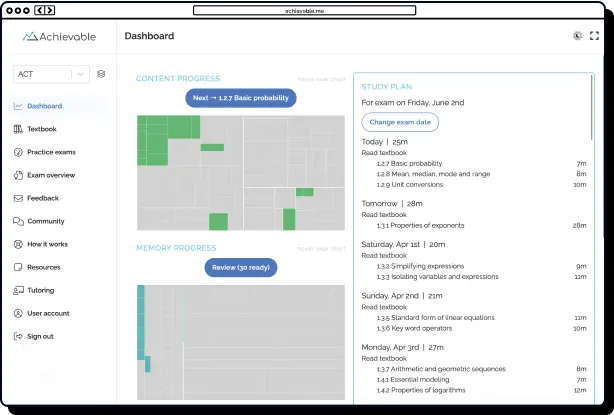
MCAT study plan for gap year medical students




Table of contents
- Build a customized MCAT study schedule for your gap year
- Unlock your MCAT advantage: The power of a diagnostic test during your gap year
- Design a structured, phase-based MCAT schedule for your gap year
- Build your content foundation (Weeks 1-8)
- Intensify practice and assessment (Weeks 9-16)
- Simulate test day and build endurance (Weeks 17-24)
- Resource planning for gap year students
- Maximize retention: Integrate review and rest into your MCAT plan
- Sample weekly structure for gap year MCAT prep:
- Adapt your MCAT study plan to real gap year commitments
- Set milestones and use ongoing self-assessment to accelerate MCAT progress
This article is part 3 of 8 of our series on making the most of your medical school gap year, where we provide you with insights on studying for the MCAT, using your time effectively, and translating your experiences into compelling narratives. In part 3, we give you inside tips on how to build a MCAT study plan that's both impactful and sustainable, helping you stay motivated as you prepare.

Build a customized MCAT study schedule for your gap year
Unlock your MCAT advantage: The power of a diagnostic test during your gap year
As a pre-med student taking a gap year, you have a unique opportunity to approach MCAT prep with strategy and purpose. Begin your preparation by taking a full-length, official diagnostic exam. This crucial step provides a clear, personalized snapshot of your current abilities and helps you tailor your study plan to your specific strengths and weaknesses.
The diagnostic exam breaks down your performance across the four MCAT sections (Chemical and Physical Foundations, CARS, Biological and Biochemical Foundations, Psychological, Social, and Biological Foundations). Rather than spending time on familiar subjects, you'll know exactly where to direct your efforts for the greatest improvement.
Studies show that your diagnostic score strongly predicts your actual MCAT performance (see research on the predictive value of full-length MCAT practice exams). Use this data to motivate yourself and create a targeted plan from day one.
How to use your diagnostic results as a gap year student:
- Study smarter, not harder: Focus only on the areas where you need the most work, saving time and energy.
- Personalize your resources: Allocate your study materials and time based on your diagnostic breakdown. For example, Dr. Tony Huynh's diagnostic helped him identify surprising strengths and weaknesses, allowing him to adjust his schedule for better results (read Dr. Tony Huynh's advice on adjusting your MCAT study schedule).
- Dig into question types: Look beyond section scores to spot patterns in the types of questions you miss, which leads to more effective review (learn how to analyze MCAT diagnostic results for targeted study).
The AAMC recommends starting with a diagnostic to map out a practical, prioritized study plan (discover why the MCAT diagnostic test is your smartest first step). For gap year students, grounding your schedule in this data means every study session counts.
Design a structured, phase-based MCAT schedule for your gap year
A gap year gives you the flexibility to treat MCAT prep as a well-organized project. By dividing your preparation into focused phases, you can maximize your productivity and keep yourself on track without the pressures of a traditional academic schedule.
Build your content foundation (Weeks 1-8)
- Dedicate set days to core sciences (such as Biology on Mondays, Chemistry on Tuesdays) to ensure thorough coverage.
- Reinforce what you learn with practice questions in the afternoons.
Focusing on one subject at a time and immediately applying new knowledge helps you retain information more effectively (see The ideal MCAT study schedule).
Intensify practice and assessment (Weeks 9-16)
In this middle phase, shift your focus to active practice: spend about two-thirds of your time on practice questions and full-length exams, and one-third reviewing areas highlighted by your diagnostic.
Keep a Missed Questions Log (MQL) to identify patterns in mistakes and review them regularly. This is key for consistent improvement (see Leah4Sci's 6-month MCAT study plan).
Simulate test day and build endurance (Weeks 17-24)
Every other week, take an official AAMC practice test under realistic conditions. This will build your test-day stamina and help you get comfortable with the MCAT format (read the MCAT exam study guide from UWorld).
With your gap year flexibility, schedule these exams when you're naturally most focused and alert.
Resource planning for gap year students
Save the official AAMC full-length exams for your final phase, using free diagnostics and third-party practice tests earlier on (get a template for creating your MCAT study schedule). With 25-30 hours per week, you can balance deep review, practice, and assessment - without academic distractions.
Summary: A phase-based, data-driven schedule ensures you make the most of your gap year. By combining content review, targeted practice, test simulations, and error analysis, you can turn this year into a launchpad for med school success.

Maximize retention: Integrate review and rest into your MCAT plan
Peak MCAT performance isn't about endless hours of study - it's about smart review and planned rest. Systematic review and taking regular breaks will help you remember more and avoid burnout during your gap year.
Why it matters for you:
Spaced repetition, spreading out review sessions, dramatically boosts retention (review the science behind distributed practice). Dr. Tyler Fara of Kaplan stresses that reviewing mistakes should be part of your routine, not an afterthought. Successful schedules, like Kaplan's 6-month study plan, include regular review and adjustments.
A high-retention weekly plan for gap year students includes:
- Dedicated review days: Reserve one day each week to revisit past material and analyze errors - this supports long-term retention (101-day MCAT study schedules).
- *Scheduled reviews can boost recall significantly compared to last-minute cramming
Don't skip rest:
Plan at least one full rest day per week. Regular breaks help you stay productive and lower your risk of burnout. The AAMC recommends at least one full rest day per week. Gap year students who rest regularly report higher productivity and less fatigue (see MCAT study productivity findings).
Sample weekly structure for gap year MCAT prep:
- Five days: Focus on new content and practice questions
- One day: Comprehensive review and analyzing mistakes
- One day: Complete rest - no academics
With 20-25 hours per week, you can schedule study sessions for your most productive times, supporting steady progress and MCAT readiness.
Adapt your MCAT study plan to real gap year commitments
Your MCAT schedule should fit around your gap year activities. Treat MCAT prep as a top priority - schedule it first, then plan other commitments around it. This approach keeps you on track and reduces stress.
Research shows that students who prioritize MCAT study before other tasks get higher scores and feel less overwhelmed (explore strategic time management strategies for pre-med students).
Practical strategies for different gap year scenarios:
- If you're doing full-time research: Set aside routine study hours outside of lab time.
- If you're working or interning: Use downtime or off-hours for MCAT work.
- If you're traveling: Use mobile MCAT apps for quick practice and flashcards (AAMC's gap year best practices report).
Students who treat MCAT prep as a non-negotiable appointment consistently see better results (read an MCAT study strategy analysis).
AAMC data shows that those who take the MCAT during less busy periods (like a gap year) score, on average, 3.2 points higher than those juggling heavy commitments.
To maximize your outcome, map your responsibilities, block out MCAT study as fixed appointments, and schedule your exam when you're least busy. This strategy keeps you motivated, lowers stress, and sets you up for the best possible score.

Set milestones and use ongoing self-assessment to accelerate MCAT progress
During your gap year, setting clear milestones and checking your progress regularly is crucial for MCAT success. High-scoring students set specific targets and use frequent self-assessment to guide their study.
How gap year students can stay on track:
- Create time-based goals: Break prep into monthly or bi-weekly checkpoints, like finishing a subject by a certain date or reaching a target score before your next practice exam.
- Schedule regular full-length exams: Every 3-4 weeks, sit for a full MCAT under test conditions (read about realistic MCAT practice exam scheduling). Use your results to pinpoint and address weak spots.
- Visualize your progress: Use a spreadsheet, calendar, or tracking app to chart modules completed and score trends. Seeing your progress keeps you motivated and highlights areas for improvement early.
- Build in feedback: Set aside weekly time for self-review or meet with a study partner to discuss errors and adjust strategies.
- Stay flexible: Use your gap year's flexibility to shift focus as needed, spending more time on difficult subjects or skills.
Ultimately, clear goals and continuous feedback transform your gap year into a period of real growth. For more strategies and templates, check out comprehensive MCAT study planning guides (read planning tips here) and see why a gap year can be the ideal time for MCAT prep (learn six reasons to delay your MCAT until your gap year).
Click here for part 4, "Build a strategic application during or after your gap year." Read on and explore how to effectively showcase your experiences gained and lessons learned to med school admissions teams.

